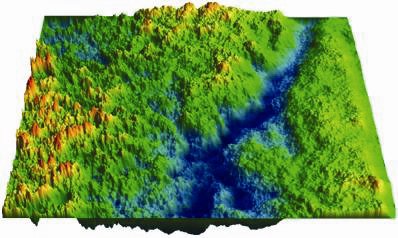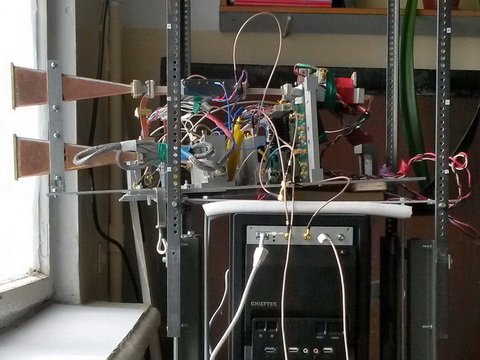Research
The research is focused on the development of airborne SAR systems for small aircrafts and also on ground-based SAR systems. The activity includes the development of novel signal processing algorithms and practical SAR systems.
Airborne SAR Systems for Small Aircrafts
An original real-time data processing technique for accurate measurement of the aircraft orientation angles has been developed [1, 2]. The application of this technique has permitted to simplify the navigation system by reducing it to a simple GPS receiver.
Efficient time-domain, multi-look, strip-map SAR processing algorithms with built-in correction of geometric distortions and multi-look correction of radiometric errors have been proposed [3-6].
A novel autofocus technique, Local-Quadratic Map-Drift Autofocus (LQMDA), has been developed [7-9]. The effeciency of the method is demonstrated in Fig. 1.
 Fig. 1. Demonstration of the LQMDA method.
Fig. 1. Demonstration of the LQMDA method.
Ku- and X-band SAR systems for small aircrafts have been developed and produced [10-12]. The efficiency of the proposed data processing methods has been confirmed on practice.
А novel approach to retrieving 3D topography of ground surfaces by measuring the Doppler frequency has been proposed [13-15] and tested (Fig. 2). The retrieval can be done just by using a single-antenna, squint-mode airborne SAR.
 Fig. 2. Example of 3D topography of a scene.
Fig. 2. Example of 3D topography of a scene.
Experimental Ground-Based SAR System
An experimental ground-based synthetic aperture radar (GB-SAR) system operating at Ka-band has been developed (Fig. 3). The radar system is designed to be operated from a top of a hill or from a roof of a building etc. for imaging of the underlying ground terrain.
 Fig. 3. Photo of the GB-SAR system.
Fig. 3. Photo of the GB-SAR system.
The radar system is placed on a trolley. Due to the motion of the trolley on the rails, the synthetic aperture is formed and the high cross-range resolution is achieved. Main characteristics of the system are listed in Table 1.
Table 1. Characteristics of the GB-SAR system.
| Radar frequency | 35 GHz |
| Transmitted power | < 1 Watt |
| Pulse repetition frequency | 2.5 kHz |
| Pulse duration | 250 µs |
| Duty cycle | 62.5% |
| 3-dB antenna beam width in horizontal / vertical plane | 40°/10° |
| LFM pulse bandwidth | 48 MHz |
| Range resolution | 4 m |
| Length of the synthetic aperture | ~ 1 m |
| Trolley motion time / speed | ~ 5 s / 20 cm/s |
|
Synthetic beam width (angular resolution) |
0.32° |
|
Azimuth (cross-range) resolution (it grows linearly with range) |
~ 1 m at range 200m |
The system operates with a high duty cycle (in a quasi-continuous mode) utilizing two separate horn antennas for simultaneous transmission of long LFM pulses and reception of radar returns. The transmitted power is as low as 1 Watt. The horn antenna forms a 40-degree beam in the horizontal plane to illuminate a wide sector of the ground scene.
A two-channel receiver is used to sample both the transmitted pulses and the backscattered radar echoes. An advanced pulse compression technique has been implemented that uses the measured transmitted pulses to provide a high dynamic range and low range-compression side lobes, as well as to achieve a high pulse-to-pulse coherency and resistance to the phase noise in the transmitted LFM pulses.
In our experiments, the system was operated indoor overviewing the nearby terrain through the open window on the 4th floor of our Institute building. An example of the obtain GB-SAR image along with the Google Map image of the scene shown in Fig. 4. The combination of these two images is also shown in Fig. 4, and it helps to match various elements of the scene to radar echoes in the GB-SAR image. For example, in the center of the image one can recognize the radar return from the aircraft Let L-410 Turbolet.
 Fig. 4. GB-SAR, GoogleMap, and merged GoogleMap+GB-SAR images of the scene.
Fig. 4. GB-SAR, GoogleMap, and merged GoogleMap+GB-SAR images of the scene.
References
| 1. O.O. Bezvesilniy, V.V. Vinogradov and D.M. Vavriv: Estimating Doppler centroid and autofocusing for airborne SAR, Proceedings of the International Radar Symposium IRS 2005, Berlin, Germany, pp.59-63 (2005) |
| 2. D.M. Vavriv, V.V. Vinogradov, V.A. Volkov, R.V. Kozhin, O.O. Bezvesilniy, S.V. Alekseenkov, A.V. Shevchenko, A. Belikov, M.P. Vasilevsky and D.I. Zaikin: Cost-Effective Airborne SAR, Radio Physics and Radio Astronomy, Vol. 11, #3, pp.276-297 (2006) |
| 3. O.O. Bezvesilniy, I.M. Gorovyi, S.V. Sosnytskiy, V.V. Vinogradov and D.M. Vavriv: SAR Processing Algorithm with Built-In Geometric Correction, Radiofizika i Radioastronomia, Vol. 16, #1, pp.98-108 (2011) |
| 4. O.O. Bezvesilniy, I.M. Gorovyi, V.V. Vinogradov and D.M. Vavriv: Multi-look radiometric correction of SAR images, Radiofizika i radioastronomiya, Vol. 16, #4, pp.424-432 (2011) |
| 5. O.O. Bezvesilniy, I.M. Gorovyi, S.V. Sosnytskiy, V.V. Vinogradov and D.M. Vavriv: Multi-Look Stripmap SAR Processing Algorithm with Built-In Correction of Geometric Distortions, Proceedings of the European Conference on Synthetic Aperture Radar (EuSAR'2010), 7-10 June 2010, Aachen, Germany, pp.712-715 (2010) |
| 6. O.O. Bezvesilniy, I.M. Gorovyi, S.V. Sosnytskiy, V.V. Vinogradov and D.M. Vavriv: Improving SAR Images: Built-In Geometric and Multi-Look Radiometric Corrections, Proceedings of the 7th European Radar Conference (EuRAD'2010), 30 September - 1 October 2010, Paris, France, pp.256-259 (2010) |
| 7. O.O. Bezvesilniy, I.M. Gorovyi and D.M. Vavriv: Local-Quadratic Map-Drift Autofocus for Synthetic Aperture Radars, Radiofizika i Radioastronomia, Vol. 17, #2, pp.182-193 (2012) (in Russian) |
| 8. O.O. Bezvesilniy, I.M. Gorovyi and D.M. Vavriv: Estimation of Phase Errors in SAR Data by Local-Quadratic Map-Drift Autofocus, Proceedings of the 13th International Radar Symposium (IRS-2012), Warsaw, Poland, May 23-25, 2012, pp.376-381 (2012) |
| 9. O.O. Bezvesilniy, I.M. Gorovyi and D.M. Vavriv: Efficient estimation of residual trajectory deviations from SAR Data, Proceedings of the 10th European Radar Conference (EURAD-2013), 9-11 October 2013, Nuremberg, Germany, pp.188-191 (2013) |
| 10. O.O. Bezvesilniy and D.M. Vavriv: Synthetic Aperture Radar Systems for Small Aircrafts: Data Processing Approaches, In: Recent Advances in Aircraft Technology, Edited by R.K. Agarwal, Published by InTech (Croatia) (ISBN 978-953-51-0150-5), Chapter 20, pp.465-498 (2012) |
| 11. D.M. Vavriv and O.O. Bezvesilniy: Developing SAR for Small Aircrafts in Ukraine, Proc. of the 2011 IEEE MTT-S International Microwave Symposium (IMS 2011), 5-10 June 2011, Baltimore, USA, pp.1-4 (2011) |
| 12. D.M. Vavriv, O.O. Bezvesilniy, R.V. Kozhin, V.V. Vinogradov, V.A. Volkov, I.M. Gorovyi and S.S. Sekretarov: X-Band SAR System for Light-Weight Aircrafts, Proceedings of the 15th International Radar Symposium (IRS 2014) (June 16-18, Gdansk, Poland), pp.501-505 (2014) |
| 13. O.O. Bezvesilniy, I.V. Dukhopelnykova, V.V. Vinogradov and D.M. Vavriv: Retrieving 3-D topography by using a single-antenna squint-mode airborne SAR, IEEE Transactions on Geoscience and Remote Sensing, Vol. 45, #11, pp.3574-3582 (2007) |
| 14. O.O. Bezvesilniy, I.V. Dukhopelnykova, V.V. Vinogradov and D.M. Vavriv: Retrieving 3D Relief from Radar Returns with Single-Antenna, Strip-Map Airborne SAR, Proceedings of the 6th European Conference on Synthetic Aperture Radar EUSAR2006, Dresden, Germany, May 16-18 (2006) |
| 15. O.O. Bezvesilniy, V.V. Vinogradov and D.M. Vavriv: High-Accuracy Doppler Measurements for Airborne SAR Applications, Proceedings of the 5th European Radar Conference (EuRAD'2008), 30–31 October 2008, Amsterdam, The Netherlands, pp.29-32 (2008) |
